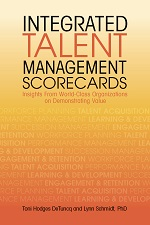ATD Blog
Introduction to Integrated Talent Management Scorecards
Mon Aug 19 2013

How do you define integrated talent management (TM)? How does your company define it? Even though the phrase has been in vogue for many years, there seems to be a lack of clarity on the definition. In the soon-to-be-released ASTD Press book, Integrated Talent Management Scorecards: Insights from World-Class Organizations on Demonstrating Value (DeTuncq & Schmidt, September 2013) integrated TM is defined as “united functions with a common goal of building employee capabilities to increase business performance.” But even when you have a common definition, the functions that organizations place under the TM umbrella tend to vary from business to business.
What functions would you put under the TM umbrella? What human capital or human resource functions does it make sense to integrate to be able to effectively build employee capabilities to increase business performance? Our webcast on September 5 presents a TM model that integrates workforce planning, talent acquisition, performance management, learning and development, succession management, and retention and engagement. The premise is that united or integrated TM functions can provide better solutions that will have a greater impact on business results than TM functions that operate in silos. And why might that be?
I’m sure you can come up with many reasons. You probably have worked in silos in human resources or other departments—and how well did that work? With a great deal of effort, communication, and collaboration it can work. But when TM functions are integrated you can eliminate redundancy, remove duplication of effort, and reduce the time it takes to develop and implement solutions. In addition, an integrated TM organization can be held accountable for the end-to-end delivery of TM solutions that affect business results. And an integrated TM organization can better align its goals with the strategic goals of the business—that is difficult to do when all of the functions are operating in silos.
How can a TM organization demonstrate its value to the organization? We recommend using an Integrated TM Scorecard Model that has three tiers of micro and macro scorecards: TM Initiative Micro Scorecards, TM Functional Macro Scorecards, and a TM Organizational Macro Scorecard. More to come on these scorecards next week in the next installment of our blog on integrated TM scorecards.
Let us know your thoughts on integrating the TM functions: What have been your experiences working in silos versus working in an integrated TM organization?
